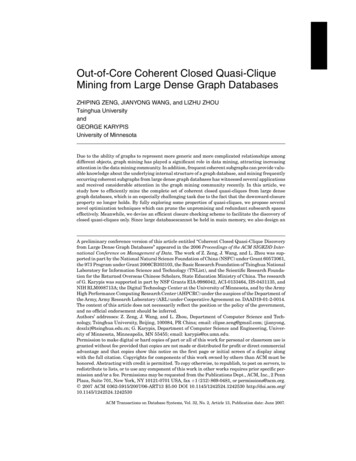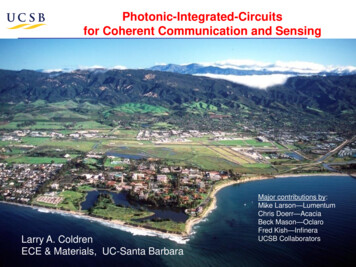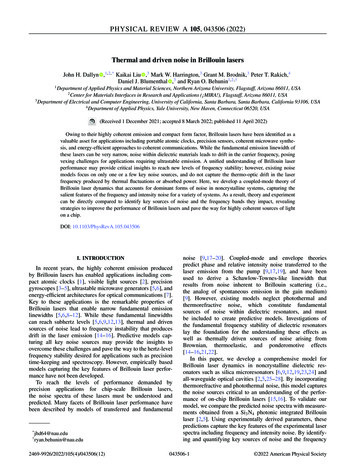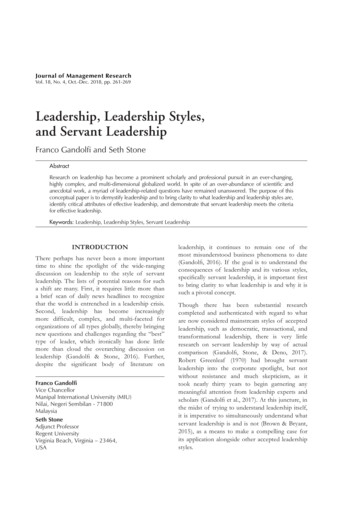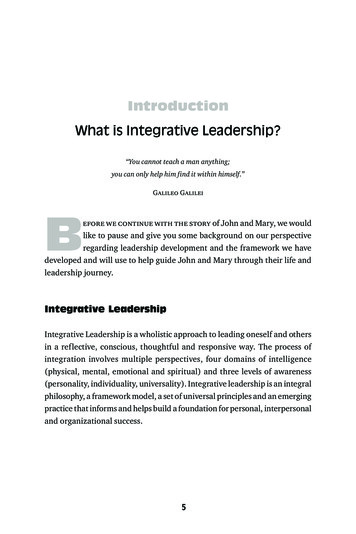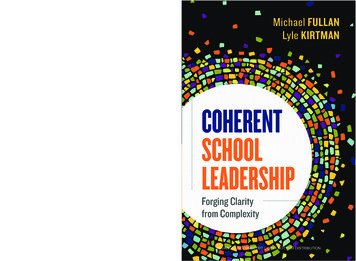
Transcription
EDUCATIONCoherent School Leadership will show you how to combine the components of Fullan’s CoherenceFramework (the Framework) with Kirtman’s 7 Competencies for Highly Effective Leaders (theCompetencies) to drive coherence—the shared depth of understanding about the nature of the workand how it impacts the results desired for student achievement—to change the culture in schoolsfrom reactive to proactive. Fullan and Kirtman, whose work is based in practice, will Show you how to use specificcompetencies to drive coherence. Provide examples that show howother leaders have successfullycreated coherence. Guide you through the day-to-daydistractions/stresses so that you canstay on course. Show you how to use the Competenciesin relation to the Framework.Taking a world view of the forces that could destabilize education and the work of coherence,Coherent School Leadership will show how proven frameworks such as the Framework and theCompetencies can help you cope with even the most complex scenarios.Lyle Kirtman has been a leadershipdevelopment consultant for morethan 30 years. As CEO of FutureManagement Systems Inc., he hasworked on developing leaders to increase results forstudents in 350 school districts in 15 states. His bookshave influenced educational practices throughout theUnited States and internationally.BROWSE EXCERPTS FROM ASCD BOOKS:www.ascd.org/booksMany ASCD members receivedthis book as a member benefitupon its initial release.Learn more at www.ascd.org/memberbooksAlexandria, Virginia USAFULLAN & KIRTMANMichael Fullan, OC, is the former Deanof the Ontario Institute for Studies inEducation and Professor Emeritus ofthe University of Toronto. A prolific,award-winning author, he is co-leader of the NewPedagogies for Deep Learning global initiative(npdl.global).Michael FULLANLyle KIRTMANCOHERENT SCHOOL LEADERSHIPWhile leaders may desire or have been told that they must put certain structures into place in orderto enhance their leadership capabilities, they may not know exactly what structures are needed, orthe skills that are required for implementation. Authors Michael Fullan and Lyle Kirtman go beyondsimply telling you what you need to put in place to enhance leadership—they detail the route tosuccessful leadership.COHERENTSCHOOLLEADERSHIPForging Clarityfrom ComplexityADVANCE UNCORRECTED COPY - NOT FOR DISTRIBUTION
1703 N. Beauregard St. Alexandria, VA 22311-1714 USAPhone: 800-933-2723 or 703-578-9600 Fax: 703-575-5400Website: www.ascd.org E-mail: member@ascd.orgAuthor guidelines: www.ascd.org/writeRonn Nozoe, Interim CEO and Executive Director; Stefani Roth, Publisher; Genny Ostertag,Director, Content Acquisitions; Julie Houtz, Director, Book Editing & Production; Joy Scott Ressler,Editor; Judi Connelly, Senior Art Director; Khanh Pham, Graphic Designer; Circle Graphics,Typesetter; Kelly Marshall, Interim Manager, Production Services; Shajuan Martin,E-Publishing Specialist; Tristan Coffelt, Production Specialist.Copyright 2019 ASCD. All rights reserved. It is illegal to reproduce copies of this work in print orelectronic format (including reproductions displayed on a secure intranet or stored in a retrieval systemor other electronic storage device from which copies can be made or displayed) without the priorwritten permission of the publisher. By purchasing only authorized electronic or print editions andnot participating in or encouraging piracy of copyrighted materials, you support the rights of authorsand publishers. Readers who wish to reproduce or republish excerpts of this work in print or electronicformat may do so for a small fee by contacting the Copyright Clearance Center (CCC), 222 RosewoodDr., Danvers, MA 01923, USA (phone: 978-750-8400; fax: 978-646-8600; web: www.copyright.com). Toinquire about site licensing options or any other reuse, contact ASCD Permissions at www.ascd.org/permissions, or permissions@ascd.org, or 703-575-5749. For a list of vendors authorized to license ASCDe-books to institutions, see www.ascd.org/epubs. Send translation inquiries to translations@ascd.org.ASCD and ASCD LEARN. TEACH. LEAD. are registered trademarks of ASCD. All other trademarkscontained in this book are the property of, and reserved by, their respective owners, and are used foreditorial and informational purposes only. No such use should be construed to imply sponsorship orendorsement of the book by the respective owners.All web links in this book are correct as of the publication date below but may have become inactiveor otherwise modified since that time. If you notice a deactivated or changed link, please e-mailbooks@ascd.org with the words “Link Update” in the subject line. In your message, please specify theweb link, the book title, and the page number on which the link appears.PAPERBACK ISBN: 978-1-4166-2790-6 ASCD product #118040PDF E-BOOK ISBN: 978-1-4166-2792-0; see Books in Print for other formats.Quantity discounts are available: e-mail programteam@ascd.org or call 800-933-2723, ext. 5773, or703-575-5773. For desk copies, go to www.ascd.org/deskcopy.ASCD Member Book No. FY19-9 (Aug. 2019 P). ASCD Member Books mail to Premium (P),Select (S), and Institutional Plus (I ) members on this schedule: Jan, PSI ; Feb, P; Apr, PSI ; May, P;Jul, PSI ; Aug, P; Sep, PSI ; Nov, PSI ; Dec, P. For current details on membership, see www.ascd.org/membership.Library of Congress Cataloging-in-Publication DataNames: Fullan, Michael, author. Kirtman, Lyle.Title: Coherent school leadership: forging clarity from complexity / Michael Fullan and Lyle Kirtman.Description: Alexandria, VA: ASCD, 2019. Includes bibliographical references and index.Identifiers: LCCN 2019010118 (print) LCCN 2019011098 (ebook) ISBN 9781416627920 (Pdf) ISBN 9781416627906 (pbk.: alk. paper)Subjects: LCSH: Educational leadership—United States. School management and organization—United States.Classification: LCC LB2805 (ebook) LCC LB2805 .F846 2019 (print) DDC 371.2—dc23LC record available at https://lccn.loc.gov/201901011827 26 25 24 23 22 21 20 191 2 3 4 5 6 7 8 9 10 11 12ADVANCE UNCORRECTED COPY - NOT FOR DISTRIBUTION15161-00 FM-3rdPgs.indd 417/06/2019 2:41 PM
Coherent School Leadership:Forging Clarity from ComplexityMichael Fullan & Lyle KirtmanChapter One Organizational Coherence and LeadershipCompetencies . . . . . . . . . . . . . . . . . . . . . . . . . . . . . . . . . . 1Chapter Two The 7 Competencies for Highly Effective Leadersin Action . . . . . . . . . . . . . . . . . . . . . . . . . . . . . . . . . . . . 11Chapter Three The Coherence Framework in Action . . . . . . . . . . . . . . . 36Chapter FourImplementation and Execution Is Key . . . . . . . . . . . . . . 51Chapter FiveLeadership for the Future . . . . . . . . . . . . . . . . . . . . . . . . 93References . . . . . . . . . . . . . . . . . . . . . . . . . . . . . . . . . . . . . . . . . . . . . . . 108Index . . . . . . . . . . . . . . . . . . . . . . . . . . . . . . . . . . . . . . . . . . . . . . . . . . . 110About the Authors . . . . . . . . . . . . . . . . . . . . . . . . . . . . . . . . . . . . . . . . . 114ADVANCE UNCORRECTED COPY - NOT FOR DISTRIBUTION15161-00 FM-3rdPgs.indd 717/06/2019 2:41 PM
1ORGANIZATIONAL COHERENCEAND LEADERSHIP COMPETENCIESWe’ve each spent more than three decades developing our own key theoriesof change—built from practice. For us, most insights come from close workthrough ongoing partnerships with those at all levels of the education systemattempting to bring about positive change. Although a book that we wrote(Kirtman & Fullan, 2016) brought these ideas and insights about positivechange management together, it didn’t do so at as deep a level as this book will.In this book, we will turn our attention to what we didn’t discuss previously—how to create coherence systems in today’s fragmented and reactive world ofeducation. Here we will discuss how to create coherence in both structure andbehaviors and equip leaders to continuously improve their craft to providethe learning environment that students need to be successful in a fast-paced,dynamic world.Fullan and QuinnFullan’s latest consolidation of ideas can be found in Coherence: The RightDrivers in Action for Schools, Districts, and Systems (Fullan & Quinn, 2016). Basedon close work with schools, districts, and states over the past decade, FullanADVANCE UNCORRECTED COPY - NOT FOR DISTRIBUTION15161-01 CH01-3rdPgs.indd 1117/06/2019 2:40 PM
2COHERENT SCHOOL LEADERSHIPand Quinn concluded that organizations are most likely to suffer fromfragmentation and overload when achieving focus was a problem. However,good focus is more than simple alignment; it must be supported by clarityand coherence. They defined coherence as “the shared depth of understanding about the nature of the work and how it impacts the results desired forstudent achievement” (p. 1). In other words, it is fully and solely subjective.People often confuse alignment—making sure things are in a logicalorder—with coherence—the emotional state of grasping the clear meaningof a phenomenon.To make it more challenging, coherence, in order to be effective, must beshared (i.e., the group must have a clear sense of where they want to go andare going). This is what makes it difficult to achieve. With all the commotion and churn, people have to obtain a good, subjective sense of their worklife and organization and, to a large degree, they must share it. Fullan andQuinn, through their work with school districts and state systems, concludedthat coherence consists of four interactive components—focusing direction,cultivating collaborative cultures, deepening learning, and securing accountability—and that leadership, which is at the core the framework, drills downand deals with the components individually and interactively (see Figure 1.1).The first component of the Coherence Framework (the Framework)—focusing direction—is about vision and goals and consists of strategies tobegin the coherence process. Developing the direction in practice requirespurposefully cultivating collaborative cultures that begin to develop the essential capacities, at both the individual and collective levels, that will be neededgoing forward (the second component). The third component—deepeninglearning (the pedagogy or learning and teaching skills to engage and helpstudents learn)—is at the heart of successful change.They also found that traditional approaches to accountability (the fourthcomponent), which emphasize tests and corrective action, were not effectiveat stimulating progress and that what worked was a focus on a few ambitiousgoals, collaborative work in relation to those goals, good engaging pedagogy,and accountability that developed within the group and, in turn, related toexternal accountability requirements.ADVANCE UNCORRECTED COPY - NOT FOR DISTRIBUTION15161-01 CH01-3rdPgs.indd 217/06/2019 2:40 PM
Organizational Coherence and Leadership Competencies3FIGURE 1.1The Coherence FrameworkFinally, Fullan and Quinn found that coherence is not static—not something that one can achieve and it’s done—but is continuous. There are threethings that make coherence continuous: People come and go in an organization and each personnel change represents a coherence-making challenge and opportunity; The environment or context constantly changes in unpredictableways—new technologies, population shifts, the economy, the future ofjobs, climate, diversity, global and regional conflict, and the like; and,hopefully, People in an organization get new ideas—they innovate or engage incontinuous improvement.ADVANCE UNCORRECTED COPY - NOT FOR DISTRIBUTION15161-01 CH01-3rdPgs.indd 317/06/2019 2:40 PM
4COHERENT SCHOOL LEADERSHIPOverall, practitioners loved the Framework. It seemed to provide ananswer to the problem of what to do with so many pieces that did nothang together. But, like most things that seem to be too good to be true, itwas! Practitioners asked, “How do we get and keep coherence if we don’thave it?” Although one could make some progress by working directly withthe four components (the components) of the Framework, that was notenough. So, rather than focus solely on the components of coherence, Fullan and Quinn considered the skills and competencies that would be requiredto develop and maintain coherence. It was at this point that they decidedto revisit Kirtman’s 7 Competencies for Highly Effective Leaders and identify how to incorporate them into promoting organizational coherence andsustainable change.KirtmanThe observation of highly effective leaders in action toward identifyingthe skills that were associated with their success led to the development ofKirtman’s 7 Competencies for Highly Effective Leaders (the Competencies).The characteristics that the observed leaders shared were the ability to: challenge the status quo, build trust through clear communications and expectations, create a commonly owned plan for success, focus on team over self,maintain a high sense of urgency regarding change and sustainable results,commit to continuous improvement of self and the organization, and buildexternal networks/partnerships—in effect, the competencies that constitutethe leadership core of the Framework.Fullan and Kirtman: A Marriage of FrameworksThe Competencies, as validated as they are, focused on the individual leader. There was a need for a solution that connected knowledgeabout individual leadership and organizational effectiveness. Hence, thisbook.The Competencies do not “function” in the same manner—that is, somecompetencies “push” change and some “pull” change (see Figure 1.2).ADVANCE UNCORRECTED COPY - NOT FOR DISTRIBUTION15161-01 CH01-3rdPgs.indd 417/06/2019 2:40 PM
Organizational Coherence and Leadership Competencies5FIGURE 1.2Competencies That Push Change and Competencies That Pull ChangeCompetencies That PUSH ChangeCompetencies That PULL Change1. Challenges the status quo3. Creates a commonly owned planfor success2. Builds trust through clearcommunications and expectations4. Focuses on team over self5. Has a high sense of urgency forchange and sustainable results6. Is committed to continuousimprovement of self and theorganization7. Builds external networks/partnershipsNoteCompetency 7—Builds external networks/partnerships—cannot cleanly be categorized asa “push” or “pull” competency. In some instances, a partnership may involve bringing anexternal party into the school or district toward benefiting the school or district and in otherinstances, a partnership may be beneficial for both the external organization and the district.We can then explicitly link the components of the Framework and theCompetencies (see Figure 1.3).We know from our work on leading change that effective change requiresthat the components of the Framework be combined with leadership competencies that both “push” and “pull.”A SCHOOL IN TROUBLEAn urban school in the northeast was declared underperformingbased on the statewide assessment. The school was not improvingwith the compliance requirements of the state. The teachers feltdefeated and were embarrassed to be associated with the school—theADVANCE UNCORRECTED COPY - NOT FOR DISTRIBUTION15161-01 CH01-3rdPgs.indd 517/06/2019 2:40 PM
6COHERENT SCHOOL LEADERSHIPlowest-performing school in the district. The superintendent suggestedthat the principal try a new approach to increase test scores. Theprincipal used the Framework and focused on each of the components. The state provided guidance on setting clear direction for success based on data analysis. A focus on literacy was the core area forsustainable success.FIGURE 1.3Linking the Components of the Framework and the CompetenciesCoherence Framework ComponentsCompetencies for HighlyEffective LeadersFocusing directionChallenges the status quoCultivating collaborative culturesBuilds trust through clear communications and expectations; focuses onteam over self; creates a commonlyowned plan for successDeepening learningBuilds external networks/partnershipsSecuring accountabilityIs committed to continuous improvementof self and the organization; has ahigh sense of urgency for change andsustainable resultsCollaboration is where many districts go wrong. Many systems, ironically,mandate collaboration and adopt the strategy known as professional learningcommunities (PLCs). The Boston Consulting Group (BSG) conducted a studyof teacher learning funded by the Gates Foundation and presented its findingsin a report entitled Teachers Know Best (2014). The BSG found that althougha high percentage of administrators valued PLCs as a strategy for improvingschools, a much smaller percentage of teachers embraced PLCs. At the sametime, when teachers were asked how they liked to learn, they named many ofADVANCE UNCORRECTED COPY - NOT FOR DISTRIBUTION15161-01 CH01-3rdPgs.indd 617/06/2019 2:40 PM
Organizational Coherence and Leadership Competencies7the putative elements of PLCs—working with and learning from other teachers,examining student work together, and so on. What was happening in the caseat hand was that the district—the urban northeast district—had a history ofteachers working in silos. In fact, teachers of grades that were performing atexpected levels did not want to participate in whole-school meetings.When the state mandated collaboration, the message fell on unreceptiveears. It was only when the principal received a coach who helped her developa more sophisticated approach to collaboration that a breakthrough occurred.In effect, the intervention began to integrate the organizational solution—theFramework—with the competency skill set—the Competencies. Essentiallythe intervention enabled the focus on a “push” competency—challenges thestatus quo (Competency 1)—to begin the change process. This required working with the principal’s leadership team on challenging the current practices inthe school that were blocking success. The state’s focus on compliance—youmust collaborate—was given secondary status. The principal, in order to getthe needed support of the leadership team, needed to immediately bring tothe fore a “pull” competency—she chose builds trust through clear communications and expectations (Competency 2). The principal was transparent regarding the data, concerns, the areas on which she needed to work in order to bea better leader, and how she needed her leadership team to help her.The next competency employed to “pull in” the rest of the school—createsa commonly owned plan for success (Competency 3)—serves to mobilize thewhole staff. In this particular case, the plan was facilitated by the principaland the assistant principal with strong input from her leadership team andteam of teachers. This planning process began the true work of collaboration(Component two) and coherence. This collaborative planning process and thehonest and open conversations that took place across the school shifted theaccountability (Component four) focus from one driven by the state to a planin which all staff took ownership.A SCHOOL NO LONGER IN TROUBLEThe school’s student achievement increased by more than 50 percentin one year. The plan for success that was driven by the state wasADVANCE UNCORRECTED COPY - NOT FOR DISTRIBUTION15161-01 CH01-3rdPgs.indd 717/06/2019 2:40 PM
8COHERENT SCHOOL LEADERSHIPnow owned by the whole school. The accountability (Component four)was intrinsically driven. Today, the principal would say that the reason her school succeeded was not about curriculum and instruction,and certainly not about compliance, but that it was about a “pull”competency—focuses on team over self (Competency 4). She now had aleadership team with which to share the leadership load. Yes, the deeperlearning (Component three) was critical. However, it received tractionfor sustainable improvement through collaboration and teamwork.As we’ve shown, the combination of the components of the Frameworkand the Competencies is the route to success. We recommend using theFramework as the organizing mechanism and the Competencies as a checklistand guide to developing skills of individuals and the team. (If you choose touse Kirtman’s diagnostic instruments to build the Competencies, the components of the Framework must be the main organizer.)The Organization of This BookThis book will go beyond typical leadership books that tell you what you needto put in place to enhance leadership. We will show you how to use specificcompetencies to drive coherence. We will provide examples that show howother leaders have successfully created coherence and used the leadershipcompetencies to build sustainability. Although the examples provide models,you must extract what is relevant for your culture to begin this work. Whileour “how-to” steps will provide a platform, the order and magnitude of thesteps will depend on your needs and your school community or district. Theflow of the remaining chapters is as follows.In Chapter 2, The 7 Competencies for Highly Effective Leaders inAction, we will show you how to use the Competencies in relation to theFramework. This chapter will also provide leadership principles of the21st century that will help you apply the Competencies. For example, inthe past, challenging the status quo (Competency 1) tended to be more top-down.In today’s world of building capacity, the faculty/staff need to understand whythe status quo is being challenged and be part of the continuous learning process.ADVANCE UNCORRECTED COPY - NOT FOR DISTRIBUTION15161-01 CH01-3rdPgs.indd 817/06/2019 2:40 PM
Organizational Coherence and Leadership Competencies9Chapter 3, The Coherence Framework in Action, will explore what itwould look like to have a truly coherent district. Would everyone be usingall seven competencies? How does the behavior of the adults align with thebehavior we expect from students? How does each component of the Framework look when it is in place? How does the district hire leaders who believein and add to the skill base of coherence-making? Michael’s international perspective allows us to bring international examples to our learning and application of best practices.How can coherence stay on track despite systems overload, competinginitiatives, day-to-day crises with student behavioral issues, adult personalityconflicts, parent concerns, sudden budget cuts, school board personal agendas, tedious compliance requirements, and fragmentation that constantlydestabilizes an organization? In Chapter 4, Implementation and ExecutionIs Key, we will discuss the often-neglected expansion of leadership to includemanagement. As well, we will outline the steps to effectively implement changeand improvement in a school or district to create sustainable results and showwhy effective implementation and often-neglected execution skills are key toforming the foundation for coherent leadership.The concept of coherence is becoming more and more critical because theworld is becoming more complex, and less and less predictable. This meansthat new leadership that can effectively work in the area of coherence-making isrequired. As mentioned previously, there are three things that make coherencecontinuous (people come and go in an organization, the environment or contextchanges in unpredictable ways, people in an organization get new ideas). InChapter 5, Leadership for the Future, we will show that leaders of the futurewill need to become learners first, co-learners always, and learn to work interactively to forge the future through joint determination with those they lead. Thischapter will consider forces that could both destabilize and integrate coherencein the future. We will take a world view of the forces that could destabilize education and the work of coherence—from the technology, political, pedagogy,and policy arenas—and that will help leaders stay ahead of the curve.The net effect of this book will be to show how proven frameworks suchas the Framework and the Competencies can help you cope with even theADVANCE UNCORRECTED COPY - NOT FOR DISTRIBUTION15161-01 CH01-3rdPgs.indd 917/06/2019 2:40 PM
10COHERENT SCHOOL LEADERSHIPmost complex scenarios. Our work comes from practice. The fact that practice is going to become even more unpredictable and constantly disruptedmeans that leaders will need grounded frameworks that can help them bothinfluence and learn from the new world that is currently unfolding. Be readyfor ever-greater challenges. Learners make the best leaders—this is the causaldirection you should strive for.ADVANCE UNCORRECTED COPY - NOT FOR DISTRIBUTION15161-01 CH01-3rdPgs.indd 1017/06/2019 2:40 PM
ReferencesBoston Consulting Group. (2014). Teachers know best: Teachers’ views on professionaldevelopment. Retrieved from /Gates-PDMarketResearch-Dec5.pdfBrooks, D. (2018, March 12). Good leaders make good schools. Retrieved from hools.htmlBryk, A., & Schneider, B. L. (2004). Trust in schools: A core resource for improvement.New York: Russell Sage Foundation.Campbell, D., & Fullan, M. (In press). Local governance in education: Its nature and potential.Thousand Oaks, CA: Corwin.David, J. L. & Talbert, J. E. (2013). Turning around a high-poverty district: Learning fromSanger. San Francisco: S.H. Cowell Foundation. Retrieved from rning-From-Sanger.pdfElmore, R. (2004). School reform from the inside out. Cambridge, MS: Harvard UniversityPress.Fullan, M. (2010). All systems go. Thousand Oaks, CA: Corwin.Fullan, M. (2013). Motion leadership in action. Thousand Oaks, CA: Corwin.Fullan, M. (2014). The principal: Three keys to maximizing impact. San Francisco: Jossey-Bass.Fullan, M. (2017). Indelible leadership: Always leave them learning. Thousand Oaks, CA:Corwin.Fullan, M. (2019). Nuance: Why some leaders succeed and others fail. Thousand Oaks, CA:Corwin.Fullan, M. & Boyle, A. (2014). Big-city school reforms: Lesson from New York, Toronto, andLondon. New York, Teachers College Press.Fullan, M., & Edwards, M. A. (2017). The power of unstoppable momentum: Key drivers torevolutionize your district. Bloomington, IN: Solution Tree.Fullan, M. & Hargreaves, A. (2016). Bringing the profession back in. Oxford, OH: LearningForward. Retrived from f/bringing-the-profession-back-in.pdfFullan, M., & Pinchot, M. (2018). The fast track to sustainable turnaround. EducationalLeadership, 75(6), 48–54.Fullan, M., & Quinn, J. (2016). Coherence: The right drivers in action for schools, districts, andsystems. Thousand Oaks, CA: Corwin.Fullan, M., Quinn, J., & Adam, E. (2016). The taking action guide to building coherence inschools, districs, and systems. Thousand Oaks, CA: Corwin.108ADVANCE UNCORRECTED COPY - NOT FOR DISTRIBUTION15161-06 REFS-3rdPgs.indd 10817/06/2019 3:09 PM
References 109Fullan, M., Quinn, J., & McEachen, J. (2018). Deep learning: Engage the world, change theworld. Thousand Oaks, CA: Corwin.Hargreaves, A., & Fullan, M. (2012). Professional capital: Transforming teaching in everyschool. New York: Teachers College Press.Hargreaves, A., & O’Connor, M.T. (2018). Collaborative Professionalism: When teachingtogether means learning for all. Thousand Oaks, CA: Corwin.Kirtman, L. (2014). Leadership and teams: The missing piece of the educational reform puzzle.Upper Saddle River, NJ: Pearson Education.Kirtman, L., & Fullan, M. (2016). Leadership: Key competencies for whole-system change.Bloomington, IN: Solution Tree.Knowles, M. S. (1988). The modern practice of adult education: From pedagogy to andragogy.Boston: Cambridge Book Company.Kotter, J. P. (2008). A sense of urgency. Boston: Harvard Business Press.Mehta, J. (2015). The allure of order: High hopes, dashed expectations, and the troubled quest toremake American schooling. New York: Oxford University Press.Mintzberg, H. (2008). Managers not MBAs: A hard look at the soft practice of managing andmanagement development. Oakland, CA: Berrett-Koehler Publishers.Pfeffer, J., & Sutton, R. I. (2006). Hard facts, dangerous half-truths, and total nonsense.Boston: Harvard Business School Press.Rose, T. (2017). The end of average: How we succeed in a world that values sameness.New York: HarperCollins.Shaw, G. B. (n.d.). Quote retrieved from https://www.brainyquote.com/quotes/georgebernard shaw 385438ADVANCE UNCORRECTED COPY - NOT FOR DISTRIBUTION15161-06 REFS-3rdPgs.indd 10917/06/2019 3:09 PM
About the AuthorsMichael Fullan, OC, is the former Dean of the OntarioInstitute for Studies in Education and Professor Emeritusof the University of Toronto. He is co-leader of theNew Pedagogies for Deep Learning global initiative(npdl.global). Recognized as a worldwide authorityon educational reform, he advises policymakers andlocal leaders on how to achieve the moral purpose of all children learning.Fullan received the Order of Canada in December 2012. He holds honorarydoctorates from several universities around the world.Fullan is a prolific, award-winning author whose books have been published in many languages. His latest books are: The Principal: Three Keys forMaximizing Impact; Coherence: Putting the Right Drivers in Action (with JoanneQuinn); Deep Learning: Engage the World, Change the World (with Joanne Quinnand Joanne McEachen); Surreal Change: The Real Life of Transforming PublicEducation (autobiography); Core Governance (with Davis Campbell); andNuance: Why Some Leaders Succeed and Others Fail. For more information onbooks, articles, and videos, please go to www.michaelfullan.ca.Lyle Kirtman has been a leadership development consultant for more than 30 years. As CEO of Future Management Systems Inc., he has worked on developingleaders to increase results for students in 350 school districts in 15 states. Kirtman’s publications are influencingeducators nationally and internationally. His books,114ADVANCE UNCORRECTED COPY - NOT FOR DISTRIBU
books@ascd.org with the words “Link Update” in the subject line. In your message, please specify the web link, the book title, and the page number on which the link appears. PAPERBACK ISBN: 978-1-4166-2790-6 ASCD product #118040 PDF E-BOOK ISBN: 978-1-4166-2792-
